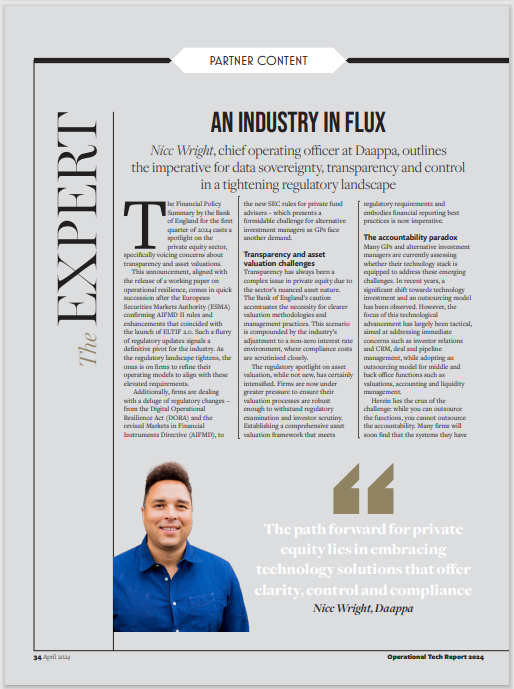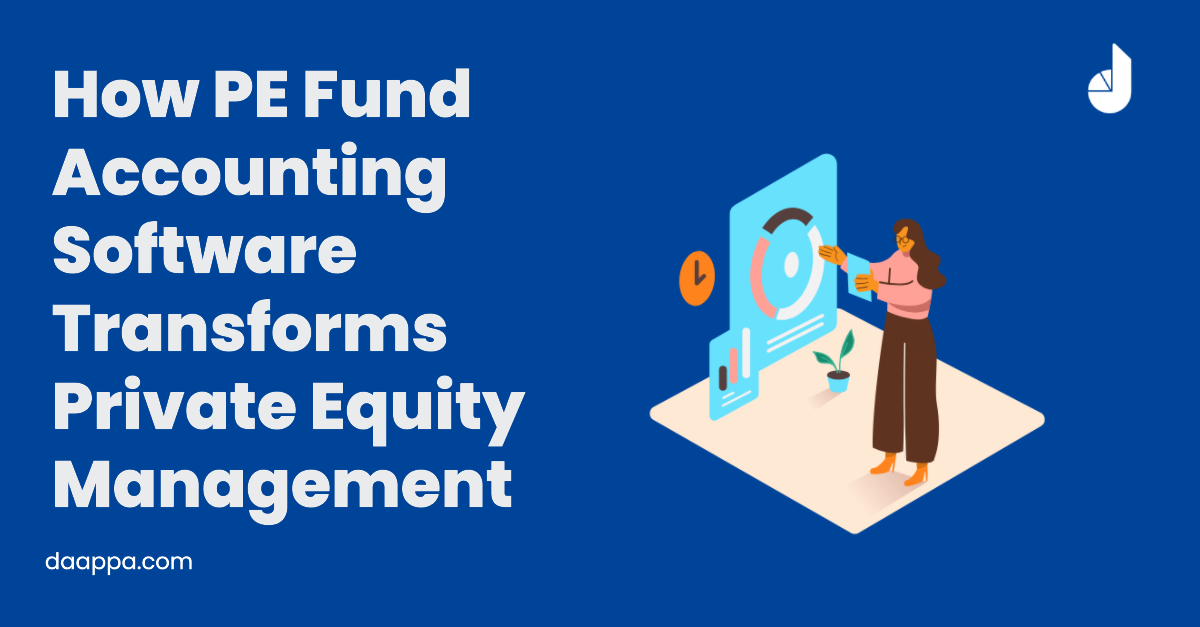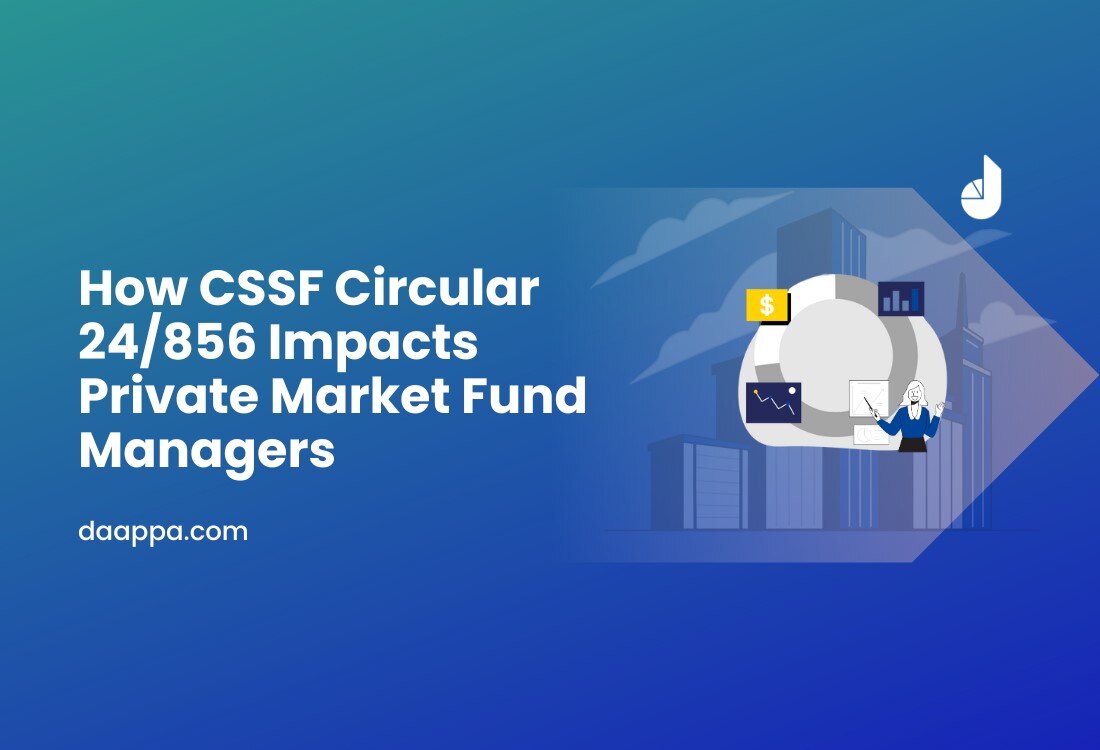How PE Fund Accounting Software Transforms Private Equity Management
In today’s competitive private equity (PE) landscape, precision and performance are inseparable. Fund managers are under mounting pressure to deliver transparency, maintain...
Nicc Wright, shares his expert insights on the challenges and technological advancements shaping the private equity sector in his article featured in The Drawdown's "Operational Technology Report 2024." This detailed analysis, now accessible in the full report, emphasises the critical need for data sovereignty, transparency, and regulatory compliance as the industry navigates a complex regulatory environment. Explore how daappa’s innovative solutions are driving operational excellence and adaptability in the private equity landscape. Read Nicc’s full discussion and the complete report here.

The Financial Policy Summary by the Bank of England for the first quarter of 2024 casts a spotlight on the private equity sector, specifically voicing concerns about transparency and asset valuations.
This announcement, aligned with the release of a working paper on operational resilience, comes in quick succession after the European Securities Markets Authority (ESMA) confirming AIFMD II rules and enhancements that coincided with the launch of ELTIF 2.0. Such a flurry of regulatory updates signals a definitive pivot for the industry. As the regulatory landscape tightens, the onus is on firms to refine their operating models to align with these elevated requirements.
Additionally, firms are dealing with a deluge of regulatory changes – from the Digital Operational Resilience Act (DORA) and the revised Markets in Financial Instruments Directive (AIFMD), to the new SEC rules for private fund advisers – which presents a formidable challenge for alternative investment managers as GPs face another demand.
Transparency has always been a complex issue in private equity due to the sector’s nuanced asset nature. The Bank of England’s caution accentuates the necessity for clearer valuation methodologies and management practices. This scenario is compounded by the industry’s adjustment to a non-zero interest rate environment, where compliance costs are scrutinised closely.
The regulatory spotlight on asset valuation, while not new, has certainly intensified. Firms are now under greater pressure to ensure their valuation processes are robust enough to withstand regulatory examination and investor scrutiny. Establishing a comprehensive asset valuation framework that meets regulatory requirements and embodies financial reporting best practices is now imperative.
Many GPs and alternative investment managers are currently assessing whether their technology stack is equipped to address these emerging challenges. In recent years, a significant shift towards technology investment and an outsourcing model has been observed. However, the focus of this technological advancement has largely been tactical, aimed at addressing immediate concerns such as investor relations and CRM, deal and pipeline management, while adopting an outsourcing model for middle and back office functions such as valuations, accounting and liquidity management.
Herein lies the crux of the challenge: while you can outsource the functions, you cannot outsource the accountability. Many firms will soon find that the systems they have invested in are not built for purpose or require customisations and configurations that were never intended. Many will turn to spreadsheets, thinking that this is sufficient. However, as the ‘Dear CEO’ letters to the asset management community in the early 2010s underscored, there will be a gradual but relentless increase in demand for transparency and valuation requirements, culminating in the necessity for sophisticated software solutions capable of independent verification and comprehensive data management.
Firms aiming to be ahead of the curve will be pleased to know that a built-for-purpose software solution is available today. Drawing from our extensive experience in the asset management industry, we have anticipated these challenges and developed a solution that demonstrates to boards, regulators, auditors and clients that firms can maintain comprehensive oversight and integrity over their data and operational processes.
The Bank of England’s warnings mark a critical juncture for private equity firms to reassess their approach to transparency and asset valuation. As the regulatory framework grows increasingly complex, demonstrating control, transparency and valuation independence becomes pivotal. For forward-thinking firms that want to stay ahead of the curve, daappa stands out as an essential tool for navigating these challenges. By ensuring data sovereignty, enabling shadow accounting and facilitating comprehensive compliance and reporting capabilities, daappa enables firms to not only meet regulatory expectations but to set new standards for industry excellence.
In an era defined by regulatory rigour and operational complexity, the path forward for private equity lies in embracing technology solutions that offer clarity, control and compliance. daappa embodies this next step, providing the cornerstone for firms aiming to thrive in the challenging yet rewarding landscape of private equity.
Acknowledging the evolving landscape, daappa has been at the forefront developing solutions that directly address emerging challenges
Data sovereignty
Achieving data sovereignty entails comprehensive control over data, a factor becoming increasingly critical under the scrutiny of regulators. Firms reliant on data management via outdated systems or via spreadsheets from third-party services will likely face intensified scrutiny. daappa’s DataHub product is a private equity functional data warehouse designed specifically to help firms create a single source of truth, offering seamless integration with core systems and third-party platforms, and enabling smooth data flow and interoperability. Datahub’s ready-built and customisable schema is built for private equity and debt funds, and provides calculated key performance indicators including IRR, TVPI and DPI. This underpins our analytics, look-through, portfolio monitoring, valuation, compliance and reporting capabilities.
Business intelligence and reporting
This is particularly crucial for internal stakeholder reporting but also to meet the needs of regulators such as that demanded by the SEC, AIFMD and local regulators. With daappa’s private assets-specific business intelligence software, clients can have access to a library of reports and dashboards, and can easily produce branded, consolidated and customised dashboards from multiple data sources, making it simple to share this information with internal or external stakeholders.
daappa’s Extractor AI app elevates business intelligence and reporting by employing machine learning for instant, market-leading accuracy in data extraction from complex PDFs, transforming portco documents into structured, actionable data. Platforms like ours are necessary for the market as it offers operational efficiency to users and productivity of data extraction tasks; ultimately empowering clients to make swift, informed decisions across their portfolios. daappa’s platform also facilitates meeting reporting requirements within the same application, adding an additional benefit.
Operational resilience
The UK's operational resilience paper and the EU’s DORA highlight the importance of having resilient operational practices, especially for outsourced functions such as fund accounting. This can be challenging if firms are relying on spreadsheets from third-party administrators to verify the fund valuations and there is typically a time lag in receiving such data, meaning firms often are obliged to pay for an enhanced service.
The lesson learnt from the asset management world is that a low-touch software solution such as daappa – that can automate the collection and validation of data from a third-party administrator and produce an independent or shadow valuation while acting as a contingent valuation point in case of an outage – is no longer just a nice-to-have.
Transparency
Transparency can be interpreted in more than one way but really comes down to having the full picture of all investments and investors to demonstrate to regulators and investors that you are in control and are ready to head off any potential issues.
daappa’s clients are already ahead of the curve in this sense with our look-through engine that enables firms to visualise the entire investment structure, including third-party entities, and to slice and dice the views in ways that demonstrate to any internal and external stakeholders that you are in control.
This tool allows for the visualisation of the complete investment structure of any given investor, counterparty investment or fund through the display of key analytics, including exposure and multi-currency assessment for both simple and complex investment structures.
Regulatory compliance
For entities engaging with ELTIF or LTAF frameworks, adherence to specific rules, such as concentration limits, is critical. daappa Studio+ Compliance offers a multi-criteria, rule- based engine that helps firms align portfolio exposures with regulatory mandates efficiently, ensuring compliance with ESG, mandate performance and funding risk management.
To find out more about daappa contact Nicholas Wright (UK & Ireland) or Renato Moreschi (EMEA)

In today’s competitive private equity (PE) landscape, precision and performance are inseparable. Fund managers are under mounting pressure to deliver transparency, maintain...
.png)
Amid rising operating costs and a shortage of experienced talent in Europe’s financial services sector, daappa Ltd and OneNexus Outsourcing Services LLP announce a strategic...

With the introduction of CSSF Circular 24/856 on 1 January 2025, private market fund managers operating in Luxembourg face stricter oversight on NAV calculation errors, investment...